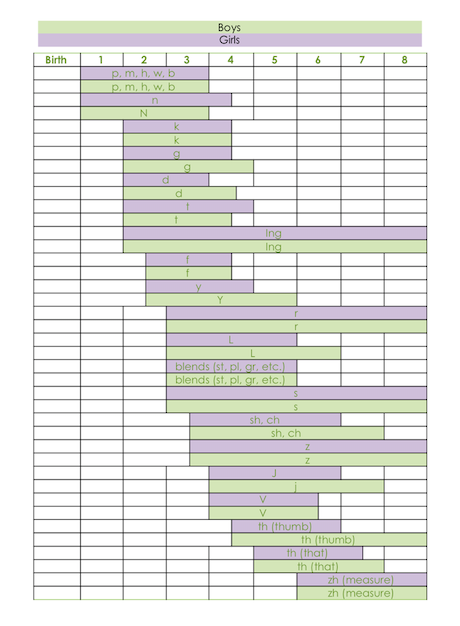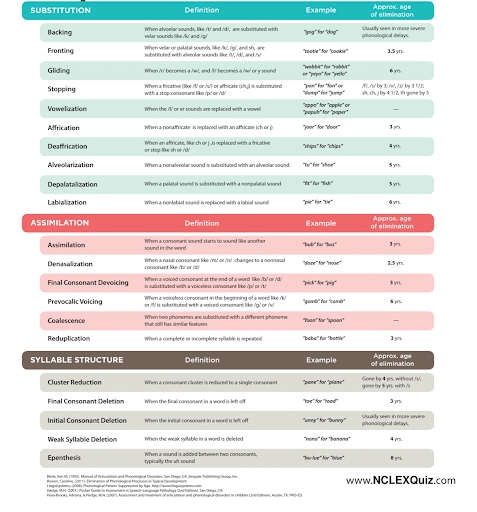By: Kyle Mutch, M.S. CCC-SLP
Chart design by: Christina Mikalef
“Should my child be saying the “k” sound?” “My child still says, “wabbit” – is that okay?” “I think it’s really cute when my child says ‘ticken’ for ‘chicken’, but should they still be doing that?”
These are all questions parents should be asking. We love when parents tune in to their child’s speech sounds and are curious about their development!
What is articulation?
When we say “articulation”, we are assessing a child’s acquisition of individual sounds and the process by which sounds, syllables, and words are formed. It emphasizes speech-motor control of the child’s tongue, jaw, lips, and palate, to produce sounds. Articulation errors include substitutions, omissions, additions, and distortions.
Here’s a guide to help you know what’s typical and determine if your child is on track to meet articulation milestones. Although every child is unique and develops at his/her own rate, it is important for parents, teachers, and professionals to know what is developmentally appropriate to help determine what isn’t!
When should my child be able to say ____?
Research has published various sets of sound acquisition norms based on studies conducted to determine when a child should reach “mastery” of a speech sound.
Here are the most commonly used norms by speech-language pathologists based on research by Sander, 1972. Your child should master the skills listed by the end of the age ranges shown below.
Speech and Articulation Development Chart:

*All children develop sounds differently! The information in the chart should be used to determine a general range of development and should be used as a guide. If you have concerns regarding your child’s speech development, we recommend that you contact a pediatrician or speech-language pathologist. The solid bar corresponding to each sound starts when 50% of children should produce the sound, and stops at an age level when 90% of children should be able to produce the sound (from Templin, 1957; Wellman et al., 1931). Source: Sander 1972 American Speech-Language-Hearing Association.
So you’re telling me that….
We can use the chart to assess the sounds a child IS and ISN’T producing. Looking at the chart, we can see that there are different sounds acquired by different ages and that expectations for toddlers compared to preschoolers and second graders, for example, vary.
Let’s take a closer look and go through some examples. For instance, if your child just turned three, we wouldn’t expect him/ her to produce the /f/ or /l/ sounds. These types of errors are within a child’s typical development and are referred to as developmental errors.
The conclusion here: age appropriate errors do not require speech therapy. Kids are going to make errors as they are learning to speak and that is an appropriate part of development.
Are my child’s articulation skills appropriate?
- Listen to your child and make a list of the sounds he/she can and cannot produce.
- Use the chart above to see if your child uses the sounds expected for their age.
- How well can others understand them? Unfamiliar listeners should understand your child 50% of the time by the time they are two years old, 50-75% by the age of three, and 75-100% by the age of four.
- If you have concerns, I encourage you to have your child screened or evaluated by a speech-language pathologist.
But wait, you said something about Phonology too…
When listening for a child’s sounds, we aren’t only looking at their articulation skills. We are also evaluating the acquisition of sound patterns and processes underlying the production of sounds.
Phonological processes are patterned errors due to simplifications of sounds and sound patterns. Allow me to give you some examples to help make sense of all that jargon.
As a child learns how to say sounds and words they might say, “do” for “go”, “pay” for “play”, or “baba” for “bottle”. They simplify these words before they learn how to say them correctly. Just like articulation, there are ages when a child should no longer use simplifications, or as we now know them, phonological processes.
Does my child need therapy?
This chart below defines each phonological process and the age in which the process should be remediated. Remember that every child develops differently and the chart should only be used as a guide. It is important to note that there is a wide range of typical development.
A phonological delay may be present if your child presents with one or more phonological processes past the approximate age of elimination. You may want to also take into consideration how easy it is to understand your child.
If you have any concerns, please contact a speech-language pathologist for a screening or evaluation.

Visit Mommy Speech Therapy to download the chart!
Please let us know if you have any questions. We’d love to hear from you!

